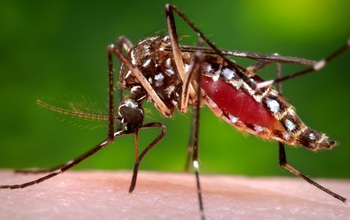
Press Release 15-095
To slow the spread of infectious diseases, NSF, NIH, USDA support new research

Scientists will study how diseases are transmitted among humans, other animals and the environment 
EEID scientists will study the effects of temperature on vector-borne disease transmission.
Credit and Larger Version August 26, 2015 Emerging pandemic disease outbreaks such as Ebola increasingly threaten global public health and world economies, scientists say. We can expect five such new diseases to emerge each year--and spread. The tropical disease dengue fever, for example, has made its way to Florida and Texas, seemingly to stay. Is our interaction with the environment somehow responsible for the increase in incidence of these diseases? A joint program of the National Science Foundation (NSF), National Institutes of Health (NIH) and the U.S. Department of Agriculture (USDA) is seeking answers. The Ecology and Evolution of Infectious Diseases (EEID) program supports efforts to understand the underlying ecological and biological mechanisms behind human-induced environmental changes and the emergence and transmission of infectious diseases. A complex process The EEID program is also co-funded by the U.K.'s Biotechnology and Biological Sciences Research Council (BBSRC). This year, the program has awarded eight new grants totaling $18 million. Disease transmission is a complex process that involves disease organisms, disease vectors, disease hosts and the predators that consume those hosts. It links relatively pristine areas with human habitations and human-dominated areas. Projects supported through the EEID program allow scientists to study how large-scale environmental events--such as habitat destruction, invasions of non-native species and pollution--alter the risks of emergence of viral, parasitic and bacterial diseases in humans and other animals. Researchers supported through the EEID program are advancing basic theory related to infectious diseases, and applying that knowledge to improve our understanding of how pathogens spread through populations at a time of increasing global change. EEID research benefits The benefits of research on the ecology of infectious diseases include development of theories of how diseases are transmitted; improved understanding of unintended health effects of development projects; increased capacity to forecast disease outbreaks; and knowledge of how infectious diseases emerge and reemerge. "As demonstrated by the Ebola crisis, infectious diseases are an ongoing threat," says Sam Scheiner of NSF's Directorate for Biological Sciences and EEID program officer at NSF. "The fundamental research from these projects will help prepare us for the next outbreak, wherever it might come from." Adds Christine Jessup of NIH's Fogarty International Center, "Infectious diseases are an ongoing global health challenge, often with devastating consequences. Environmental change, population mobility, and complex socio-ecological systems underlie many infectious disease threats. Our ability to prevent and control emerging and re-emerging diseases hinges on enhanced understanding of these diseases in their ecological and evolutionary contexts." New awards to address current and future threats This year's EEID awardees will conduct research on such topics as: group living as a possible explanation for infectious disease vulnerability in social species; vector behavior in transmission ecology; effects of agricultural expansion and intensification on infections; long-distance dispersal and disease outbreaks; and effects of temperature on vector-borne disease transmission. "As we learn more about the ecology of pathogens that cause infectious diseases, we see clear links among public health, animal health, plant health, and the environment, with agriculture playing a significant role," says Sonny Ramaswamy, USDA's National Institute of Food and Agriculture director. "Through our partnership with the Ecology and Evolution of Infectious Diseases program, we are able to support agriculturally-relevant research on topics of global concern, and help ensure the safety and security of our food supply." Adds Melanie Welham, BBSRC's science director, "Global uncertainties can present new challenges, and scientific research helps us to prepare for our future. The health of our livestock, plants and crops is dependent on improved knowledge of infectious diseases. This new funding will help us respond more rapidly and effectively to emerging threats, and to safeguard health and food security." 2015 NSF-NIH-USDA-BBSRC Ecology and Evolution of Infectious Diseases Awards Kathleen Alexander, Virginia Polytechnic Institute and State University: Can group living and the influence of Allee Effects explain infectious disease vulnerability in social species? Emergence of M. mungi in the cooperative breeding banded mongoose Jason Blackburn, University of Florida: Spatio-temporally explicit estimation of R0 for pathogens with environmentally-mediated transmission Sonia Hernandez, University of Georgia: Consequences of Anthropogenic Resources for the Cross-Scale Dynamics of an Enteric Pathogen in an Avian Host Leah Johnson, University of South Florida: US-UK Collab: RCN: Vector Behavior in Transmission Ecology (VectorBiTE) Cristina Lanzas, North Carolina State University-Raleigh: Exposure heterogeneity and environmental transmission dynamics of Escherichia coli Erin Mordecai, Stanford University: Effects of temperature on vector-borne disease transmission: integrating theory with empirical data Christopher Mundt, Oregon State University: Long-Distance Dispersal and Disease Outbreaks: Effects of Initial Prevalence, Basic Reproduction Number, and Control Tactics Jason Rohr, University of South Florida: Effects of Agricultural Expansion and Intensification on Infections -NSF- 
Media Contacts
Cheryl Dybas, NSF, (703) 292-7734, cdybas@nsf.gov Related Websites
NSF Special Report: Ecology and Evolution of Infectious Diseases:http://www.nsf.gov/news/special_reports/ecoinf/
NSF Discovery Article Series: Ecology and Evolution of Infectious Diseases:http://nsf.gov/discoveries/disc_summ.jsp?cntn_id=134947
NSF News (2014 EEID Awards): Racing ahead of disease outbreaks: $12 million in new research grants:http://nsf.gov/news/news_summ.jsp?cntn_id=132570
NSF News (2013 EEID Awards): Outbreak: Ecology and Evolution of Infectious Disease grants support research on disease transmission:http://www.nsf.gov/news/news_summ.jsp?cntn_id=129280
NSF News (2012 EEID Awards): Controlling the Spread of Diseases Among Humans, Other Animals and the Environment:http://www.nsf.gov/news/news_summ.jsp?cntn_id=125496 | 































